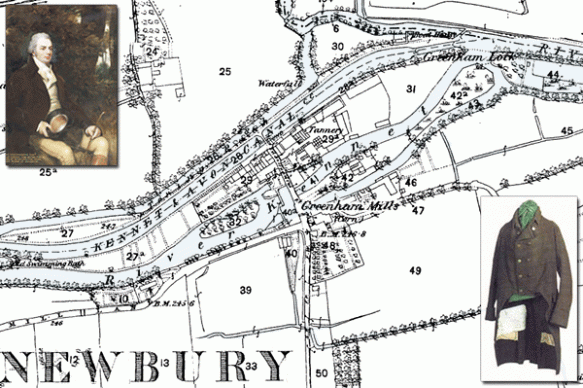
Newbury, Berkshire – Map: Ordnance Survey Old Series 1817
In June 1811, John Coxeter, a well-known cloth manufacturer, the owner of nearby Greenham Mills, took on the challenge of the making of a legendary coat for Sir John Throckmorton.
Coxeter, is reported to have said “So great are the improvements in machinery I have lately introduced into my mill, that I believe that in twenty- four hours I could take the coat off your back, reduce it to wool, and turn it back into a coat again”.
So impressed was Sir John with Coxeter’s claim that not long after the conversation had taken place, Sir John Throckmorton laid a bet of a thousand guineas that at eight o’clock in the evening of June the 25th, 1811, he would sit down to dinner in a well-woven, properly-made coat, the wool of which would come from fleeces still on the sheeps’ backs at five o’clock that same morning. Most thought the feat impossible and it was not long before his bet was eagerly accepted.
Promptly at five o’clock operations commenced, and no time was lost in getting the sheep shorn, the wool was washed, spun, and woven. The cloth was manufactured, dyed and prepared by four o’clock in the afternoon. Just eleven hours after the arrival of the two sheep in Coxeter’s mill-yard. The cloth was now put into the hands of the tailors. Mr. James White, together with nine of his men, began the process of turning the cloth into a “well woven, properly made coat”. For the next two and a quarter hours the tailors were busy cutting out, stitching, pressing, and sewing on buttons and at twenty minutes past six Mr. Coxeter presented the coat to Sir John Throckmorton, who, before over five thousand people who had gathered to watch, put on the coat and sat down to dinner with 40 invited guests in time for dinner to be taken at eight o’clock that evening.
Throckmorton won his 1000 guineas and John Coxeter had the sheep roasted for the crowds that had gathered to see the fun, as well as donating 120 gallons of beer in one of the greatest publicity stunts of the age.
The original coat is still displayed at Coughton Court near Alcester the seat of the Throckmorton family since 1409.
Newbury, however, has its own version of the coat, produced when the feat was repeated in 1991 – knocking a further hour off the record!



 Botchergate, Carlisle (MAP: OS Town Plans 1:500 – published in 1865)
Botchergate, Carlisle (MAP: OS Town Plans 1:500 – published in 1865)





 During WWII Bailey Bridges were tested at Westward Ho! as part of the Mulberry Harbour project, as well as the The Great Panjandrum. The Panjandrum is probably best know for being depicted in the Dad’s Army episode, “Round and Round Went the Great Big Wheel”, about a large, rocket-propelled, explosive-laden wheel. Unfortunately the real wheel had as many problems as the tv version and the idea never saw service.
During WWII Bailey Bridges were tested at Westward Ho! as part of the Mulberry Harbour project, as well as the The Great Panjandrum. The Panjandrum is probably best know for being depicted in the Dad’s Army episode, “Round and Round Went the Great Big Wheel”, about a large, rocket-propelled, explosive-laden wheel. Unfortunately the real wheel had as many problems as the tv version and the idea never saw service.
